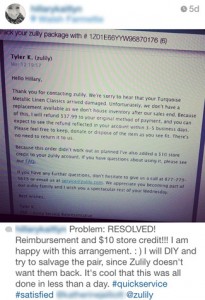Reputation management is nothing new. Business owners have always been concerned with what their customers say about them. But with the rise of the Internet, social media, and review sites like Yelp, companies are receiving more feedback than ever. It is becoming more and more difficult to keep track of who is saying what and then to address each comment appropriately.
It Starts with Good Service
I have been reading a lot of articles about how to approach reputation management online, and each author puts forth some great advice on what to do when a company receives a poor review or and angry tweet. But what I’ve noticed is that all of their tips focus on reactive behavior rather than proactive service. It stands to reason that customers who have a satisfactory experience with your business will have no need to post negative feedback online (or elsewhere). If you focus on providing a quality product or service with top-notch customer support from beginning to end, then review sites and social media actually begin to work FOR you rather than acting as a platform for disgruntled patrons to air grievances. As an example, let’s take a look at an experience my friend Hillary recently had with an online storefront.
Zulily Creating a Customer for Life
 Hillary ordered a pair of Toms shoes from Zulily.com. Upon receiving the shoes, she noticed several defects in the product. After alerting Zulily’s customer service department of the problem via email, my friend received the following response:
Hillary ordered a pair of Toms shoes from Zulily.com. Upon receiving the shoes, she noticed several defects in the product. After alerting Zulily’s customer service department of the problem via email, my friend received the following response:
“…We’re sorry to hear that your Turquoise Metallic Linen Classics arrived damaged. Unfortunately, we don’t have a replacement available as we don’t house inventory after our sales end. Because of this, I will refund $37.99 to your original method of payment…Please feel free to keep, donate or dispose of the item as you see fit…Because this order didn’t work out as planned I’ve also added a $10 store credit to your Zulily account…”

Hillary was thrilled with how her situation was handled and is now a Zulily customer for life.
Of course, there is always a chance that someone will not be completely satisfied with his or her experience with your company. Unfortunately, even when you take the correct approach to customer service, you may receive a few unflattering comments. Never fear. There are a lot of things you can do to help diffuse the situation before it takes a toll on your business.
Social Media
Social media offers a great opportunity to be proactive in your reputation management efforts. Unfortunately, however, we see a lot of businesses use social media platforms to be reactive. Companies react to the negative socia
l buzz going around after a customer has a poor experience with a product or service. In some cases this is unavoidable, but most often these situations could be avoided through consistent, and proactive, social
engagement with followers. Social media monitoring tools are a huge part of reputation management and can help companies avoid the need for reactive responses to negative social posts. Tools such as Google alerts, Twazzup, Social Mention, and others allow businesses to see what is being said about their brand so they can manage their public reputation on a regular basis rather than simply react to a problem.
Review Sites
Review websites can be a business owner’s best friend or their worst enemy. Just like with social media, it is important that you make a proactive effort to prevent the need for negative reviews. For example, if you run a restaurant, you may be able to avoid negative reviews on sites like Yelp and Urbanspoon by offering customers a chance to provide feedback on their experience while still in the restaurant (i.e. a comment card brought to the table with the check). The idea here is to give customers an opportunity to voice their concerns so they won’t feel the need to do so in the public sphere of the Internet. Of course business owners need to take a genuine interest in what their customers are saying in order for this suggestion to work.
If you do receive a negative review online, be sure to respond in a respectful way, acknowledging the customer’s concerns and stating what you will be doing to improve your product or service for the future. It is often better to respond to a negative review with a short, respectful reply than to say nothing and hope the review fades into the background. Try something like this: “Dear Jenny, we are so sorry to hear you did not enjoy your experience with us. We take our customers’ opinions very seriously here at [fill in the blank], and we are taking steps to improve our service to you.”
When DIY is Not Enough
As I mentioned earlier, no matter how proactive you are with reputation management, odds are that you will receive at least one bad review. There are a variety of methods you can use to recover from negative feedback, and this post only touches on a few of them. But if you find that things have gotten a little out of hand, and you are struggling with negative social media buzz or poor Yelp reviews, it may be time to turn to the professionals. WTM Digital offers reputation management services to help support your marketing efforts. See our reputation management page to request a free proposal.
